Impact of a Summer Wildfire Episode on Air Quality in a Rural Area Near the Adriatic Coast
Abstract
1. Introduction
2. Materials and Methods
2.1. Sampling Site
2.2. Sample Collection
2.3. EC and OC Analysis
2.4. Biomass-Burning Marker Determination
2.5. Meteorological Data and Hourly PM Data
3. Results and Discussion
3.1. Annual Trends of PM and Carbonaceous Compounds
3.2. Seasonal Variations of Carbonaceous Components in PM
3.3. Carbonaceous Compound Levels During the Wildfire Event
4. Conclusions
Author Contributions
Funding
Institutional Review Board Statement
Informed Consent Statement
Data Availability Statement
Acknowledgments
Conflicts of Interest
References
- Barjeste Vaezi, R.; Martin, M.R.; Hosseinpour, F. Impacts of Wildfire Smoke Aerosols on Radiation, Clouds, Precipitation, Climate, and Air Quality. Atmos. Environ. X 2025, 26, 100322. [Google Scholar] [CrossRef]
- Pio, C.A.; Legrand, M.; Alves, C.A.; Oliveira, T.; Afonso, J.; Caseiro, A.; Puxbaum, H.; Sanchez-Ochoa, A.; Gelencsér, A. Chemical Composition of Atmospheric Aerosols during the 2003 Summer Intense Forest Fire Period. Atmos. Environ. 2008, 42, 7530–7543. [Google Scholar] [CrossRef]
- Jaffe, D.A.; Wigder, N.L. Ozone Production from Wildfires: A Critical Review. Atmos. Environ. 2012, 51, 1–10. [Google Scholar] [CrossRef]
- Lopes, M.; Monteiro, A.; Mouzourides, P.; Κouis, P. The Health Burden of Wildfire Smoke in a Changing Climate: Exposure, Risks, and Strategies for Mitigation. Curr. Opin. Environ. Sci. Health 2025, 46, 100631. [Google Scholar] [CrossRef]
- Liu, J.C.; Pereira, G.; Uhl, S.A.; Bravo, M.A.; Bell, M.L. A Systematic Review of the Physical Health Impacts from Non-Occupational Exposure to Wildfire Smoke. Environ. Res. 2015, 136, 120–132. [Google Scholar] [CrossRef]
- Chen, H.; Samet, J.M.; Bromberg, P.A.; Tong, H. Cardiovascular Health Impacts of Wildfire Smoke Exposure. Part. Fibre Toxicol. 2021, 18, 2. [Google Scholar] [CrossRef]
- Karanasiou, A.; Alastuey, A.; Amato, F.; Renzi, M.; Stafoggia, M.; Tobías, A.; Reche, C.; Forastiere, F.; Gumy, S.; Mudu, P.; et al. Short-Term Health Effects from Outdoor Exposure to Biomass Burning Emissions: A Review. Sci. Total Environ. 2021, 781, 146739. [Google Scholar] [CrossRef]
- Coelho, S.; Ferreira, J.; Rodrigues, V.; Lopes, M. Source Apportionment of Air Pollution in European Urban Areas: Lessons from the ClairCity Project. J. Environ. Manag. 2022, 320, 115899. [Google Scholar] [CrossRef]
- Yuan, W.; Huang, R.J.; Yang, L.; Guo, J.; Chen, Z.; Duan, J.; Wang, T.; Ni, H.; Han, Y.; Li, Y.; et al. Characterization of the Light-Absorbing Properties, Chromophore Composition and Sources of Brown Carbon Aerosol in Xi’an, Northwestern China. Atmos. Chem. Phys. 2020, 20, 5129–5144. [Google Scholar] [CrossRef]
- Janta, R.; Sekiguchi, K.; Yamaguchi, R.; Sopajaree, K.; Pongpiachan, S.; Chetiyanukornkul, T. Ambient PM2.5, Polycyclic Aromatic Hydrocarbons and Biomass Burning Tracer in Mae Sot District, Western Thailand. Atmos. Pollut. Res. 2020, 11, 27–39. [Google Scholar] [CrossRef]
- Simoneit, B.R.T.; Schauer, J.J.; Nolte, C.G.; Oros, D.R.; Elias, V.O.; Fraser, M.P.; Rogge, W.F.; Cass, G.R. Levoglucosan, a Tracer for Cellulose in Biomass Burning and Atmospheric Particles. Atmos. Environ. 1999, 33, 173–182. [Google Scholar] [CrossRef]
- Braun, R.A.; Fraser, M.P. Influence of Wildfire Smoke on Summertime Surface Air Quality in an Urban Desert Region. Atmos. Environ. 2025, 358, 121297. [Google Scholar] [CrossRef]
- Jaffe, D.A.; O’Neill, S.M.; Larkin, N.K.; Holder, A.L.; Peterson, D.L.; Halofsky, J.E.; Rappold, A.G. Wildfire and Prescribed Burning Impacts on Air Quality in the United States. J. Air Waste Manag. Assoc. 2020, 70, 583–615. [Google Scholar] [CrossRef]
- Kaskaoutis, D.G.; Kharol, S.K.; Sifakis, N.; Nastos, P.T.; Sharma, A.R.; Badarinath, K.V.S.; Kambezidis, H.D. Satellite Monitoring of the Biomass-Burning Aerosols during the Wildfires of August 2007 in Greece: Climate Implications. Atmos. Environ. 2011, 45, 716–726. [Google Scholar] [CrossRef]
- van Drooge, B.L.; Lopez, J.F.; Grimalt, J.O. Influences of Natural Emission Sources (Wildfires and Saharan Dust) on the Urban Organic Aerosol in Barcelona (Western Mediterranean Basis) during a PM Event. Environ. Sci. Pollut. Res. 2012, 19, 4159–4167. [Google Scholar] [CrossRef]
- Alves, C.A.; Gonçalves, C.; Evtyugina, M.; Pio, C.A.; Mirante, F.; Puxbaum, H. Particulate Organic Compounds Emitted from Experimental Wildland Fires in a Mediterranean Ecosystem. Atmos. Environ. 2010, 44, 2750–2759. [Google Scholar] [CrossRef]
- Silva, P.; Carmo, M.; Rio, J.; Novo, I. Changes in the Seasonality of Fire Activity and Fire Weather in Portugal: Is the Wildfire Season Really Longer? Meteorology 2023, 2, 74–86. [Google Scholar] [CrossRef]
- Vicente, E.D.; Figueiredo, D.; Gonçalves, C.; Kováts, N.; Hubai, K.; Sainnokhoi, T.A.; Vicente, A.; Oliveira, H.; Lopes, I.; Alves, C. Toxicological Screening of PM2.5 from Wildfires Involving Different Biomass Fuels. Environ. Pollut. 2025, 370, 125887. [Google Scholar] [CrossRef]
- Koukouli, M.E.; Pseftogkas, A.; Karagkiozidis, D.; Mermigkas, M.; Panou, T.; Balis, D.; Bais, A. Extreme Wildfires over Northern Greece during Summer 2023—Part B. Adverse Effects on Regional Air Quality. Atmos. Res. 2025, 320, 108034. [Google Scholar] [CrossRef]
- Diapouli, E.; Popovicheva, O.; Kistler, M.; Vratolis, S.; Persiantseva, N.; Timofeev, M.; Kasper-Giebl, A.; Eleftheriadis, K. Physicochemical Characterization of Aged Biomass Burning Aerosol after Long-Range Transport to Greece from Large Scale Wildfires in Russia and Surrounding Regions, Summer 2010. Atmos. Environ. 2014, 96, 393–404. [Google Scholar] [CrossRef]
- Kaskaoutis, D.G.; Petrinoli, K.; Grivas, G.; Kalkavouras, P.; Tsagkaraki, M.; Tavernaraki, K.; Papoutsidaki, K.; Stavroulas, I.; Paraskevopoulou, D.; Bougiatioti, A.; et al. Impact of Peri-Urban Forest Fires on Air Quality and Aerosol Optical and Chemical Properties: The Case of the August 2021 Wildfires in Athens, Greece. Sci. Total Environ. 2024, 907, 168028. [Google Scholar] [CrossRef]
- Jakovljević, I.; Šimić, I.; Mendaš, G.; Sever Štrukil, Z.; Žužul, S.; Gluščić, V.; Godec, R.; Pehnec, G.; Bešlić, I.; Milinković, A.; et al. Pollution Levels and Deposition Processes of Airborne Organic Pollutants over the Central Adriatic Area: Temporal Variabilities and Source Identification. Mar. Pollut. Bull. 2021, 172, 112873. [Google Scholar] [CrossRef]
- Meteorological and Hydrological Bulletin 3/2024. Meteorol. Hydrol. Bull. 2024, 3, 1–51.
- Meteorological and Hydrological Bulletin 6/2024. Meteorol. Hydrol. Bull. 2024, 6, 1–53.
- Meteorological and Hydrological Bulletin 7/2024. Meteorol. Hydrol. Bull. 2024, 7, 1–59.
- Meteorological and Hydrological Bulletin 5/2024. Meteorol. Hydrol. Bull. 2024, 5, 1–59.
- National Firefighting Operations Centre Report. Available online: https://hvz.gov.hr/ (accessed on 7 May 2025).
- N1 Zagreb Hina N1 News. Available online: https://n1info.hr/english/news/croatia-records-21-increase-in-wildfires-in-2024/ (accessed on 6 May 2025).
- European Forest Fire Information System EFFIS Annual Statistics for Croatia. Available online: https://forest-fire.emergency.copernicus.eu/apps/effis.statistics/estimates (accessed on 5 May 2025).
- Croatian Firefighting Association. Available online: https://hvz.gov.hr/vijesti/dvoc-2-3-kolovoza-2024/4670 (accessed on 26 July 2025).
- EN 12341:2023; Ambient Air—Standard Gravimetric Measurement Method for the Determination of the PM10 or PM2.5 Mass Concentrat. European Committee for Standardization: Brussels, Belgium, 2023; p. 64.
- Putaud, J.-P.; Cavalli, F.; Viana, M.; Yttri, K.E.; Genberg, J. Toward a Standardised Thermal-Optical Protocol for Measuring Atmospheric Organic and Elemental Carbon: The EUSAAR Protocol. Atmos. Meas. Tech. 2010, 3, 79–89. [Google Scholar] [CrossRef]
- EN 16909:2017; Ambient Air—Measurement of Elemental Carbon (EC) and Organic Carbon (OC) Collected on Filters. European Committee for Standardization: Brussels, Belgium, 2017; pp. 1–60.
- Wu, C.; Yu, J.Z. Determination of Primary Combustion Source Organic Carbon-to-Elemental Carbon (OC/EC) Ratio Using Ambient OC and EC Measurements: Secondary OC-EC Correlation Minimization Method. Atmos. Chem. Phys. Discuss. 2016, 16, 5453–5465. [Google Scholar] [CrossRef]
- Dasari, S.; Widory, D. Radiocarbon (14C) Analysis of Carbonaceous Aerosols: Revisiting the Existing Analytical Techniques for Isolation of Black Carbon. Front. Environ. Sci. 2022, 10, 907467. [Google Scholar] [CrossRef]
- Panteliadis, P.; Hafkenscheid, T.; Cary, B.; Diapouli, E.; Fischer, A.; Favez, O.; Quincey, P.; Viana, M.; Hitzenberger, R.; Vecchi, R.; et al. ECOC Comparison Exercise with Identical Thermal Protocols after Temperature Offset Correction—Instrument Diagnostics by in-Depth Evaluation of Operational Parameters. Atmos. Meas. Tech. 2015, 8, 779–792. [Google Scholar] [CrossRef]
- Sopčić, S.; Pehnec, G.; Bešlić, I. Specific Biomass Burning Tracers in Air Pollution in Zagreb, Croatia. Atmos. Pollut. Res. 2024, 15, 102176. [Google Scholar] [CrossRef]
- Directive (EU) 2024/2881 of the European Parliament and of the Council of 23 October 2024 on ambient air quality and cleaner air for Europe (recast). Off. J. Eur. Union 2024, 2881, 1–70.
- Goodarzi, B.; Azimi Mohammadabadi, M.; Jafari, A.J.; Gholami, M.; Kermani, M.; Assarehzadegan, M.A.; Shahsavani, A. Investigating PM2.5 Toxicity in Highly Polluted Urban and Industrial Areas in the Middle East: Human Health Risk Assessment and Spatial Distribution. Sci. Rep. 2023, 13, 17858. [Google Scholar] [CrossRef]
- Zhai, G.; Zhang, L. Impact of Fine Particulate Matter 2.5 on Hospitalization for Upper Respiratory Tract Infections in Lanzhou Urban Industrial Area, China. Ann. Agric. Environ. Med. 2023, 30, 462–467. [Google Scholar] [CrossRef]
- Barriopedro, D.; Miralles, D.G.; Salcedo-Sanz, S.; García-Herrera, R.; Ordóñez, C. Heat Waves: A Growing Threat to Society and the Environment. Eos 2023, 104. [Google Scholar] [CrossRef]
- Zhang, Z.; Xu, W.; Zeng, S.; Liu, Y.; Liu, T.; Zhang, Y.; Du, A.; Li, Y.; Zhang, N.; Wang, J.; et al. Secondary Organic Aerosol Formation from Ambient Air in Summer in Urban Beijing: Contribution of S/IVOCs and Impacts of Heat Waves. Environ. Sci. Technol. Lett. 2024, 11, 738–745. [Google Scholar] [CrossRef]
- Escudero, M.; Viana, M.; Querol, X.; Alastuey, A.; Díez Hernández, P.; García Dos Santos, S.; Anzano, J. Industrial Sources of Primary and Secondary Organic Aerosols in Two Urban Environments in Spain. Environ. Sci. Pollut. Res. 2015, 22, 10413–10424. [Google Scholar] [CrossRef]
- Institute for Medical Research and Occupational Health, Annual Report ofNational Network for Air Quality Monitoring for 2024. Available online: https://iszz.azo.hr/iskzl/datoteka?id=168917 (accessed on 26 July 2025).
- DHMZ (Croatian Meteorological and Hydrological Service) Izvješće o Praćenju Kvalitete Zraka Na Postajama Državne Mreže Za Trajno Praćenje Kvalitete Zraka u 2024. Godini. Available online: https://iszz.azo.hr/iskzl/datoteka?id=168655 (accessed on 26 July 2025).
- Borlaza, L.J.; Weber, S.; Marsal, A.; Uzu, G.; Jacob, V.; Besombes, J.-L.; Chatain, M.; Conil, S.; Jaffrezo, J.-L. Nine-Year Trends of PM10 Sources and Oxidative Potential in a Rural Background Site in France. Atmos. Chem. Phys. 2022, 22, 8701–8723. [Google Scholar] [CrossRef]
- Yttri, K.E.; Aas, W.; Bjerke, A.; Cape, J.N.; Cavalli, F.; Ceburnis, D.; Dye, C.; Emblico, L.; Facchini, M.C.; Forster, C.; et al. Elemental and Organic Carbon in PM10: A One Year Measurement Campaign within the European Monitoring and Evaluation Programme EMEP. Atmos. Chem. Phys. 2007, 7, 5711–5725. [Google Scholar] [CrossRef]
- Yttri, K.E.; Simpson, D.; Bergström, R.; Kiss, G.; Szidat, S.; Ceburnis, D.; Eckhardt, S.; Hueglin, C.; Nøjgaard, J.K.; Perrino, C.; et al. The EMEP Intensive Measurement Period Campaign, 2008-2009: Characterizing Carbonaceous Aerosol at Nine Rural Sites in Europe. Atmos. Chem. Phys. 2019, 19, 4211–4233. [Google Scholar] [CrossRef]
- Dinoi, A.; Cesari, D.; Marinoni, A.; Bonasoni, P.; Riccio, A.; Chianese, E.; Tirimberio, G.; Naccarato, A.; Sprovieri, F.; Andreoli, V.; et al. Inter-Comparison of Carbon Content in PM2.5 and PM10 Collected at Five Measurement Sites in Southern Italy. Atmosphere 2017, 8, 243. [Google Scholar] [CrossRef]
- Querol, X.; Alastuey, A.; Ruiz, C.R.; Artiñano, B.; Hansson, H.C.; Harrison, R.M.; Buringh, E.; Ten Brink, H.M.; Lutz, M.; Bruckmann, P.; et al. Speciation and Origin of PM10 and PM2.5 in Selected European Cities. Atmos. Environ. 2004, 38, 6547–6555. [Google Scholar] [CrossRef]
- Putaud, J.-P.; Raes, F.; Van Dingenen, R.; Brüggemann, E.; Facchini, M.-C.; Decesari, S.; Fuzzi, S.; Gehrig, R.; Hüglin, C.; Laj, P.; et al. A European Aerosol Phenomenology—2: Chemical Characteristics of Particulate Matter at Kerbside, Urban, Rural and Background Sites in Europe. Atmos. Environ. 2004, 38, 2579–2595. [Google Scholar] [CrossRef]
- Aas, W.; Fagerli, H.; Alastuey, A.; Cavalli, F.; Degorska, A.; Feigenspan, S.; Brenna, H.; Gliß, J.; Heinesen, D.; Hueglin, C.; et al. Trends in Air Pollution in Europe, 2000–2019. Aerosol Air Qual. Res. 2024, 24, 230237. [Google Scholar] [CrossRef]
- Lee, J.; Kim, D.; Lee, J. Elemental Carbon and Its Fractions during Evolved Gas Analysis with Respect to Pyrolytic Carbon and Split Time. Appl. Sci. 2021, 11, 7544. [Google Scholar] [CrossRef]
- Turšič, J.; Podkrajšek, B.; Grgić, I.; Ctyroky, P.; Berner, A.; Dusek, U.; Hitzenberger, R. Chemical Composition and Hygroscopic Properties of Size-Segregated Aerosol Particles Collected at the Adriatic Coast of Slovenia. Chemosphere 2006, 63, 1193–1202. [Google Scholar] [CrossRef]
- Karanasiou, A.; Minguillón, M.C.; Viana, M.; Alastuey, A.; Putaud, J.-P.; Maenhaut, W.; Panteliadis, P.; Močnik, G.; Favez, O.; Kuhlbusch, T.A.J. Thermal-Optical Analysis for the Measurement of Elemental Carbon (EC) and Organic Carbon (OC) in Ambient Air a Literature Review. Atmos. Meas. Tech. Discuss 2015, 8, 9649–9712. [Google Scholar] [CrossRef]
- Rajput, P.; Sarin, M.M.; Sharma, D.; Singh, D. Organic Aerosols and Inorganic Species from Post-Harvest Agricultural-Waste Burning Emissions over Northern India: Impact on Mass Absorption Efficiency of Elemental Carbon. Environ. Sci. Process. Impacts 2014, 16, 2371–2379. [Google Scholar] [CrossRef]
- Hou, S.; Liu, D.; Xu, J.; Vu, T.; Wu, X.; Srivastava, D.; Fu, P.; Li, L.; Sun, Y.; Vlachou, A.; et al. Source Apportionment of Carbonaceous Aerosols in Beijing with Radiocarbon and Organic Tracers: Insight into the Differences between Urban and Rural Sites. Atmos. Chem. Phys. 2021, 21, 8273–8292. [Google Scholar] [CrossRef]
- Choi, J.-K.; Ban, S.-J.; Kim, Y.-P.; Kim, Y.-H.; Yi, S.-M.; Zoh, K.-D. Molecular Marker Characterization and Source Appointment of Particulate Matter and Its Organic Aerosols. Chemosphere 2015, 134, 482–491. [Google Scholar] [CrossRef]
- Mahilang, M.; Deb, M.K.; Pervez, S. Biogenic Secondary Organic Aerosols: A Review on Formation Mechanism, Analytical Challenges and Environmental Impacts. Chemosphere 2021, 262, 127771. [Google Scholar] [CrossRef]
- Plaza, J.; Artíñano, B.; Salvador, P.; Gómez-Moreno, F.J.; Pujadas, M.; Pio, C.A. Short-Term Secondary Organic Carbon Estimations with a Modified OC/EC Primary Ratio Method at a Suburban Site in Madrid (Spain). Atmos. Environ. 2011, 45, 2496–2506. [Google Scholar] [CrossRef]
- Castro, L.M.; Pio, C.A.; Harrison, R.M.; Smith, D.J.T. Carbonaceous Aerosol in Urban and Rural European Atmospheres: Estimation of Secondary Organic Carbon Concentrations. Atmos. Environ. 1999, 33, 2771–2781. [Google Scholar] [CrossRef]
- Turpin, B.J.; Huntzicker, J.J. Identification of Secondary Organic Aerosol Episodes and Quantitation of Primary and Secondary Organic Aerosol Concentrations during SCAQS. Atmos. Environ. 1995, 29, 3527–3544. [Google Scholar] [CrossRef]
- Ma, L.; Hu, D.; Yan, Y.; Niu, Y.; Duan, X.; Guo, Y.; Li, W.; Peng, L. Pollution Characteristics and Source Analysis of Carbonaceous Components in PM2.5 in a Typical Industrial City. Aerosol Air Qual. Res. 2024, 24, 240014. [Google Scholar] [CrossRef]
- Decesari, S.; Fuzzi, S.; Facchini, M.C.; Mircea, M.; Emblico, L.; Cavalli, F.; Maenhaut, W.; Chi, X.; Schkolnik, G.; Falkovich, A.; et al. Characterization of the Organic Composition of Aerosols from Rondônia, Brazil, during the LBA-SMOCC 2002 Experiment and Its Representation through Model Compounds. Atmos. Chem. Phys. 2006, 6, 375–402. [Google Scholar] [CrossRef]
- López-Caravaca, A.; Crespo, J.; Galindo, N.; Yubero, E.; Juárez, N.; Nicolás, J.F. Sources of Water-Soluble Organic Carbon in Fine Particles at a Southern European Urban Background Site. Atmos. Environ. 2023, 306, 119844. [Google Scholar] [CrossRef]
- Sopčić, S.; Godec, R.; Jakovljević, I.; Bešlić, I. The Influence of Biomass Burning on the Organic Content of Urban Aerosols. Biomass 2024, 5, 1. [Google Scholar] [CrossRef]
- Fernandes, K.S.; dos Santos, E.O.; Batista, C.E.; Ribeiro, I.O.; Piracelli, V.P.; Solci, M.C.; Duvoisin Jr., S.; Martin, S.T.; Souza, R.A.F.; Machado, C.M.D. WSOC and Its Relationship with BC, Levoglucosan and Transition Metals in the PM2.5 of an Urban Area in the Amazon. J. Braz. Chem. Soc. 2022, 33, 570–581. [Google Scholar] [CrossRef]
- Witkowska, A.; Lewandowska, A.U. Water Soluble Organic Carbon in Aerosols (PM1, PM2.5, PM10) and Various Precipitation Forms (Rain, Snow, Mixed) over the Southern Baltic Sea Station. Sci. Total Environ. 2016, 573, 337–346. [Google Scholar] [CrossRef]
- Sopčić, S.; Jakovljević, I.; Štrukil, Z.S.; Bešlić, I. Source Identification of Carbohydrates and Polycyclic Aromatic Hydrocarbons in a Rural Area near the Plitvice Lakes National Park, Croatia. Atmos. Environ. 2025, 345, 121050. [Google Scholar] [CrossRef]
- Puxbaum, H.; Caseiro, A.; Claeys, M. Levoglucosan Levels at Background Sites in Europe for Assessing the Impact of Biomass Combustion on the European Aerosol Background. J. Geophys. Res. Atmos. 2007, 112, D23S05 (1-11). [Google Scholar] [CrossRef]
- Maenhaut, W.; Vermeylen, R.; Claeys, M.; Vercauteren, J.; Matheeussen, C.; Roekens, E. Assessment of the Contribution from Wood Burning to the PM10 Aerosol in Flanders, Belgium. Sci. Total Environ. 2012, 437, 226–236. [Google Scholar] [CrossRef]
- Jedynska, A.; Hoek, G.; Wang, M.; Eeftens, M.; Cyrys, J.; Beelen, R.; Cirach, M.; De Nazelle, A.; Keuken, M.; Visschedijk, A.; et al. Spatial Variations of Levoglucosan in Four European Study Areas. Sci. Total Environ. 2015, 505, 1072–1081. [Google Scholar] [CrossRef]
- Vincenti, B.; Paris, E.; Carnevale, M.; Palma, A.; Guerriero, E.; Borello, D.; Paolini, V.; Gallucci, F. Saccharides as Particulate Matter Tracers of Biomass Burning: A Review. Int. J. Environ. Res. Public Health 2022, 19, 4387. [Google Scholar] [CrossRef]
- Zdráhal, Z.; Oliveira, J.; Vermeylen, R.; Claeys, M.; Maenhaut, W. Improved Method for Quantifying Levoglucosan and Related Monosaccharide Anhydrides in Atmospheric Aerosols and Application to Samples from Urban and Tropical Locations. Environ. Sci. Technol. 2002, 36, 747–753. [Google Scholar] [CrossRef]
- Otto, A.; Gondokusumo, R.; Simpson, M.J. Characterization and Quantification of Biomarkers from Biomass Burning at a Recent Wildfire Site in Northern Alberta, Canada. Appl. Geochem. 2006, 21, 166–183. [Google Scholar] [CrossRef]
- Šimić, I.; Godec, R.; Bešlić, I.; Davila, S. Carbon Mass Concentrations in the Air at the Plitvice Lakes National Park. Kem. u Ind. 2018, 67, P127–P133. [Google Scholar] [CrossRef]
- Yu, Q.; Chen, J.; Qin, W.; Cheng, S.; Zhang, Y.; Sun, Y.; Xin, K.; Ahmad, M. Characteristics, Primary Sources and Secondary Formation of Water-Soluble Organic Aerosols in Downtown Beijing. Atmos. Chem. Phys. 2021, 21, 1775–1796. [Google Scholar] [CrossRef]
- Pakbin, P.; Hudda, N.; Cheung, K.L.; Moore, K.F.; Sioutas, C. Spatial and Temporal Variability of Coarse (PM10-2.5) Particulate Matter Concentrations in the Los Angeles Area. Aerosol Sci. Technol. 2010, 44, 514–525. [Google Scholar] [CrossRef]
- Sigsgaard, T.; Forsberg, B.; Annesi-Maesano, I.; Blomberg, A.; Bølling, A.; Boman, C.; Bønløkke, J.; Brauer, M.; Bruce, N.; Héroux, M.E.; et al. Health Impacts of Anthropogenic Biomass Burning in the Developed World. Eur. Respir. J. 2015, 46, 1577–1588. [Google Scholar] [CrossRef]
- Van Den Heuvel, R.; Staelens, J.; Koppen, G.; Schoeters, G. Toxicity of Urban PM10 and Relation with Tracers of Biomass Burning. Int. J. Environ. Res. Public Health 2018, 15, 320. [Google Scholar] [CrossRef]
- Pardo, M.; Li, C.; Zimmermann, R.; Rudich, Y. Health Impacts of Biomass Burning Aerosols: Relation to Oxidative Stress and Inflammation. Aerosol Sci. Technol. 2024, 58, 1093–1113. [Google Scholar] [CrossRef]
- Schmidl, C.; Marr, I.L.; Caseiro, A.; Kotianová, P.; Berner, A.; Bauer, H.; Kasper-Giebl, A.; Puxbaum, H. Chemical Characterisation of Fine Particle Emissions from Wood Stove Combustion of Common Woods Growing in Mid-European Alpine Regions. Atmos. Environ. 2008, 42, 126–141. [Google Scholar] [CrossRef]
- Piazzalunga, A.; Belis, C.; Bernardoni, V.; Cazzuli, O.; Fermo, P.; Valli, G.; Vecchi, R. Estimates of Wood Burning Contribution to PM by the Macro-Tracer Method Using Tailored Emission Factors. Atmos. Environ. 2011, 45, 6642–6649. [Google Scholar] [CrossRef]
- Sandradewi, J.; Prévôt, A.S.H.; Szidat, S.; Perron, N.; Alfarra, M.R.; Lanz, V.A.; Weingartner, E.; Baltensperger, U.R.S. Using Aerosol Light Abosrption Measurements for the Quantitative Determination of Wood Burning and Traffic Emission Contribution to Particulate Matter. Environ. Sci. Technol. 2008, 42, 3316–3323. [Google Scholar] [CrossRef]
- Zotter, P.; Herich, H.; Gysel, M.; El-Haddad, I.; Zhang, Y.; Močnik, G.; Hüglin, C.; Baltensperger, U.; Szidat, S.; Prévôt, A.S.H. Evaluation of the Absorption Ångström Exponents for Traffic and Wood Burning in the Aethalometer Based Source Apportionment Using Radiocarbon Measurements of Ambient Aerosol. Atmos. Chem. Phys. Discuss. 2016, 17, 4229–4249. [Google Scholar] [CrossRef]
- Ram, K.; Sarin, M.M.; Tripathi, S.N. A 1 Year Record of Carbonaceous Aerosols from an Urban Site in the Indo-Gangetic Plain: Characterization, Sources, and Temporal Variability. J. Geophys. Res. Atmos. 2010, 115, D24313. [Google Scholar] [CrossRef]
- Singh, A.; Rajput, P.; Sharma, D.; Sarin, M.M.; Singh, D. Black Carbon and Elemental Carbon from Postharvest Agricultural-Waste Burning Emissions in the Indo-Gangetic Plain. Adv. Meteorol. 2014, 2014, 179301. [Google Scholar] [CrossRef]
- Hasegawa, S. Experimental Characterization of PM2.5 Organic Carbon by Using Carbon-Fraction Profiles of Organic Materials. Asian J. Atmos. Environ. 2022, 16, 2021128. [Google Scholar] [CrossRef]

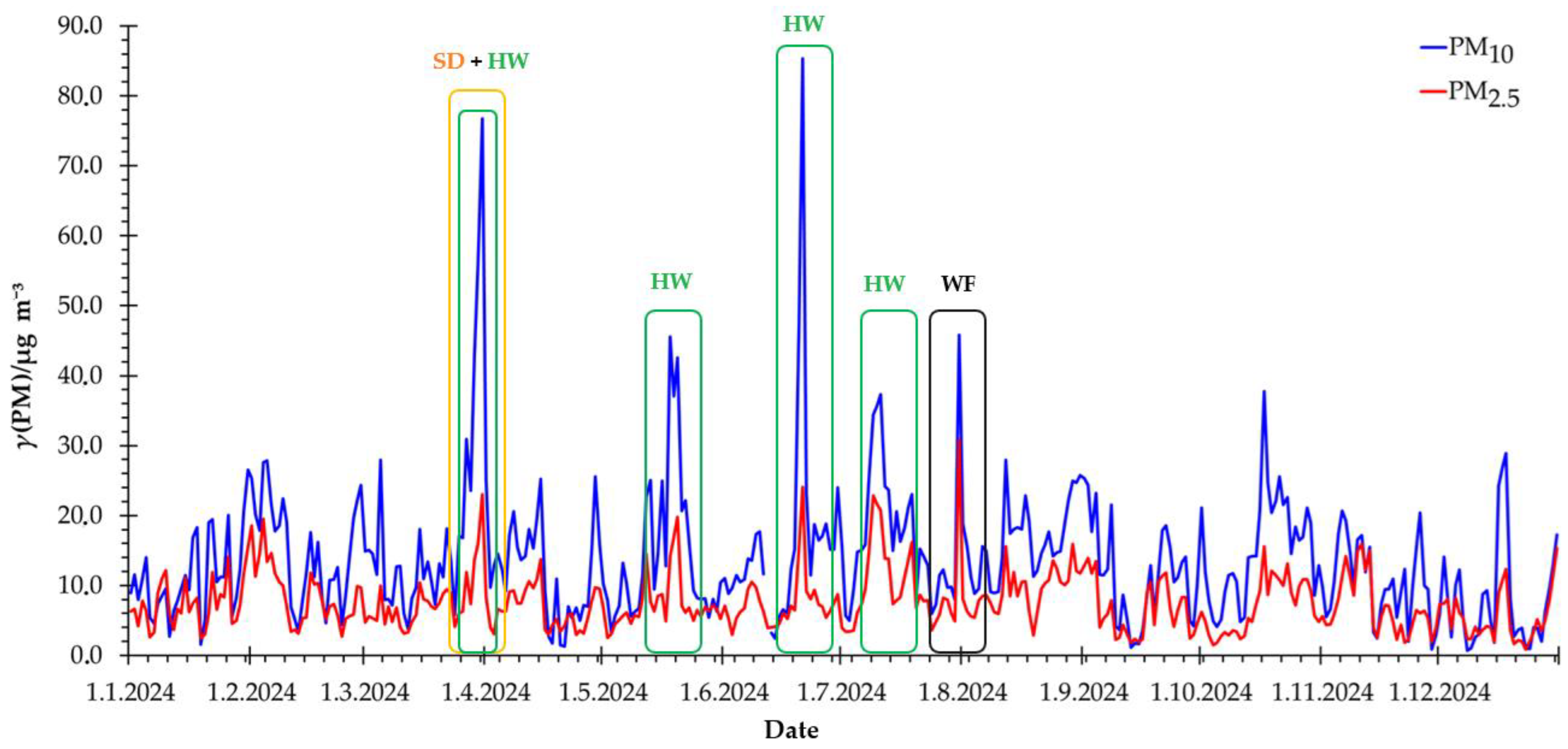
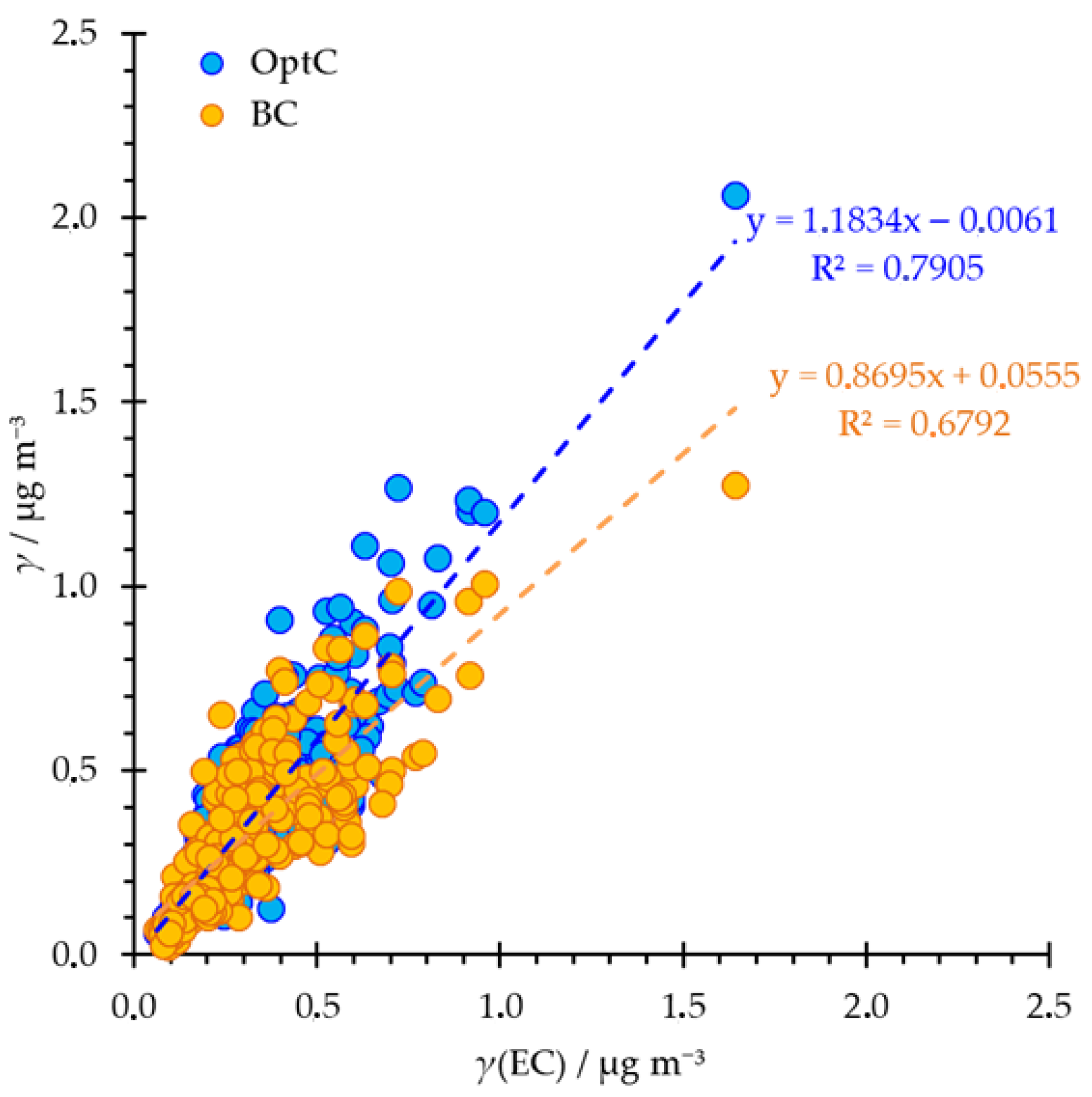

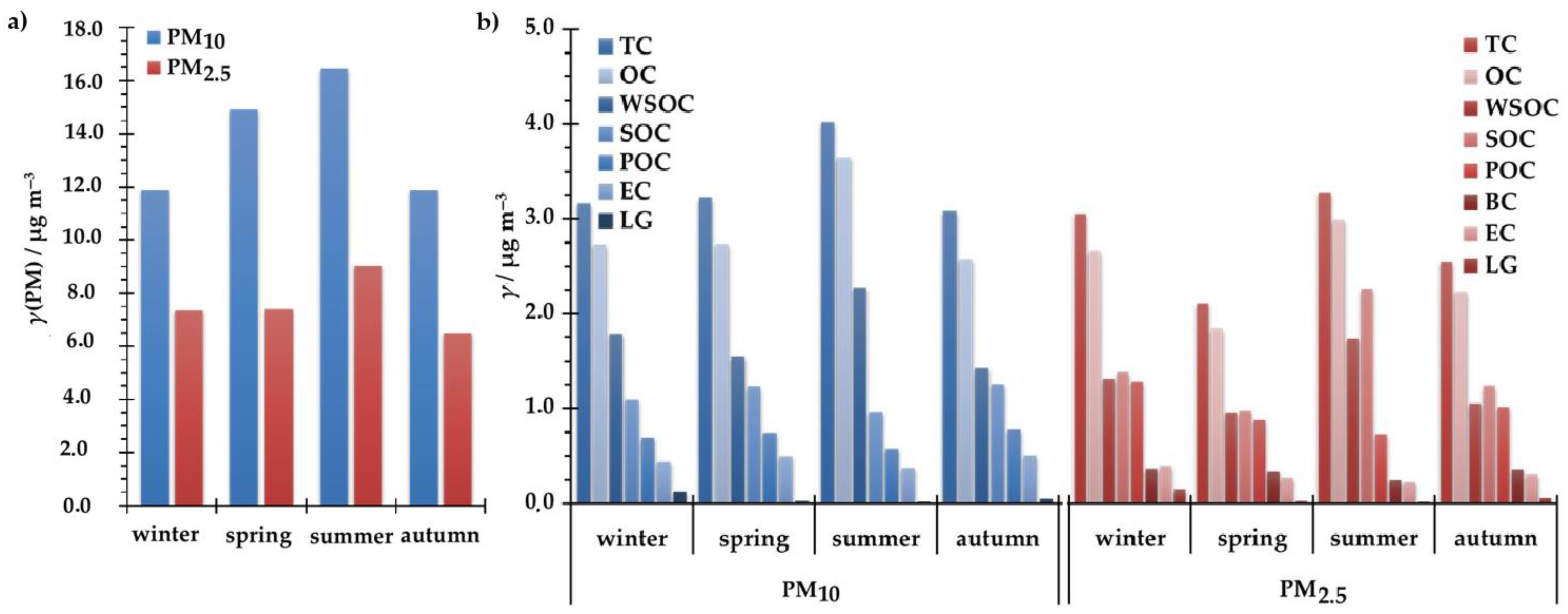
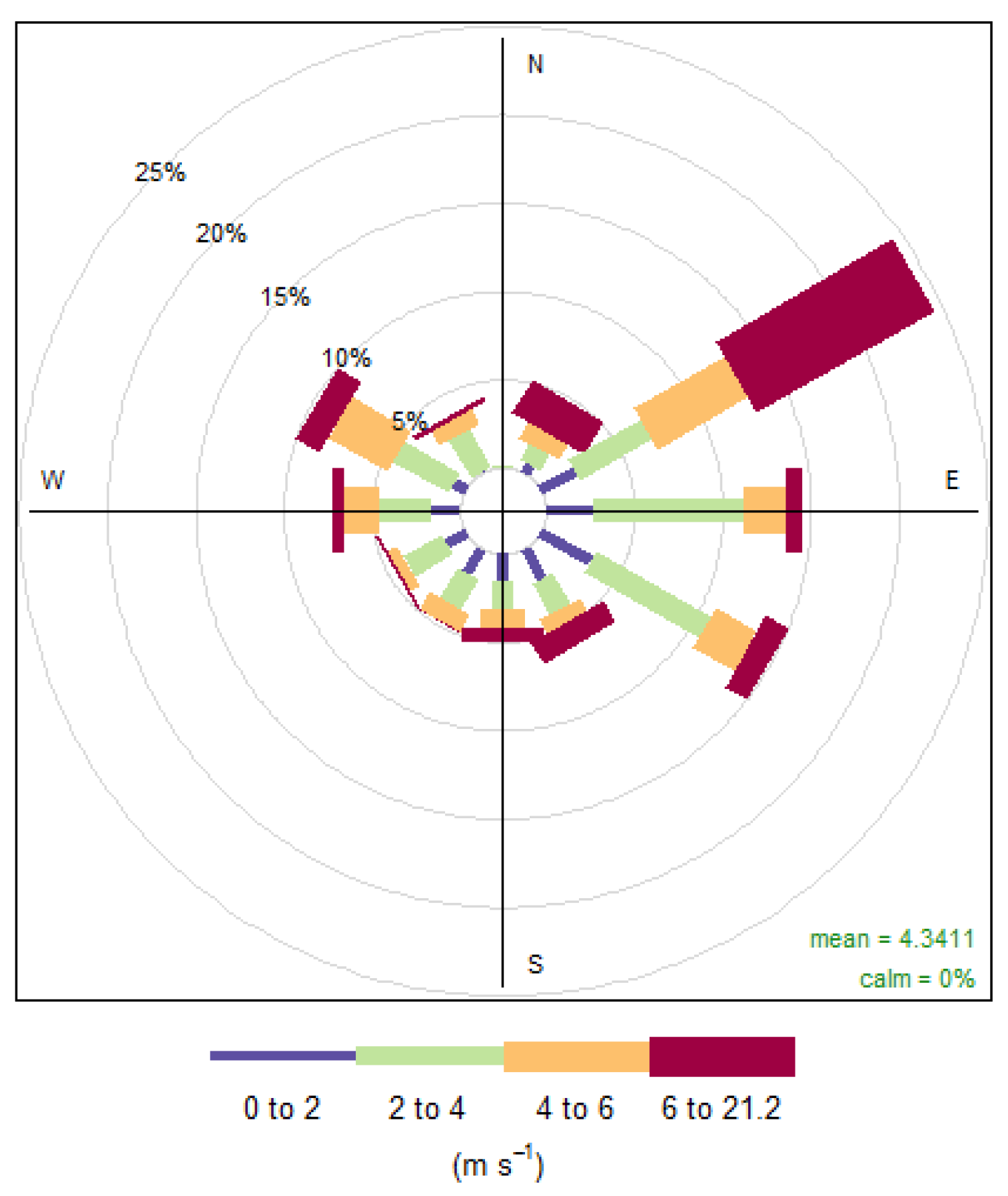


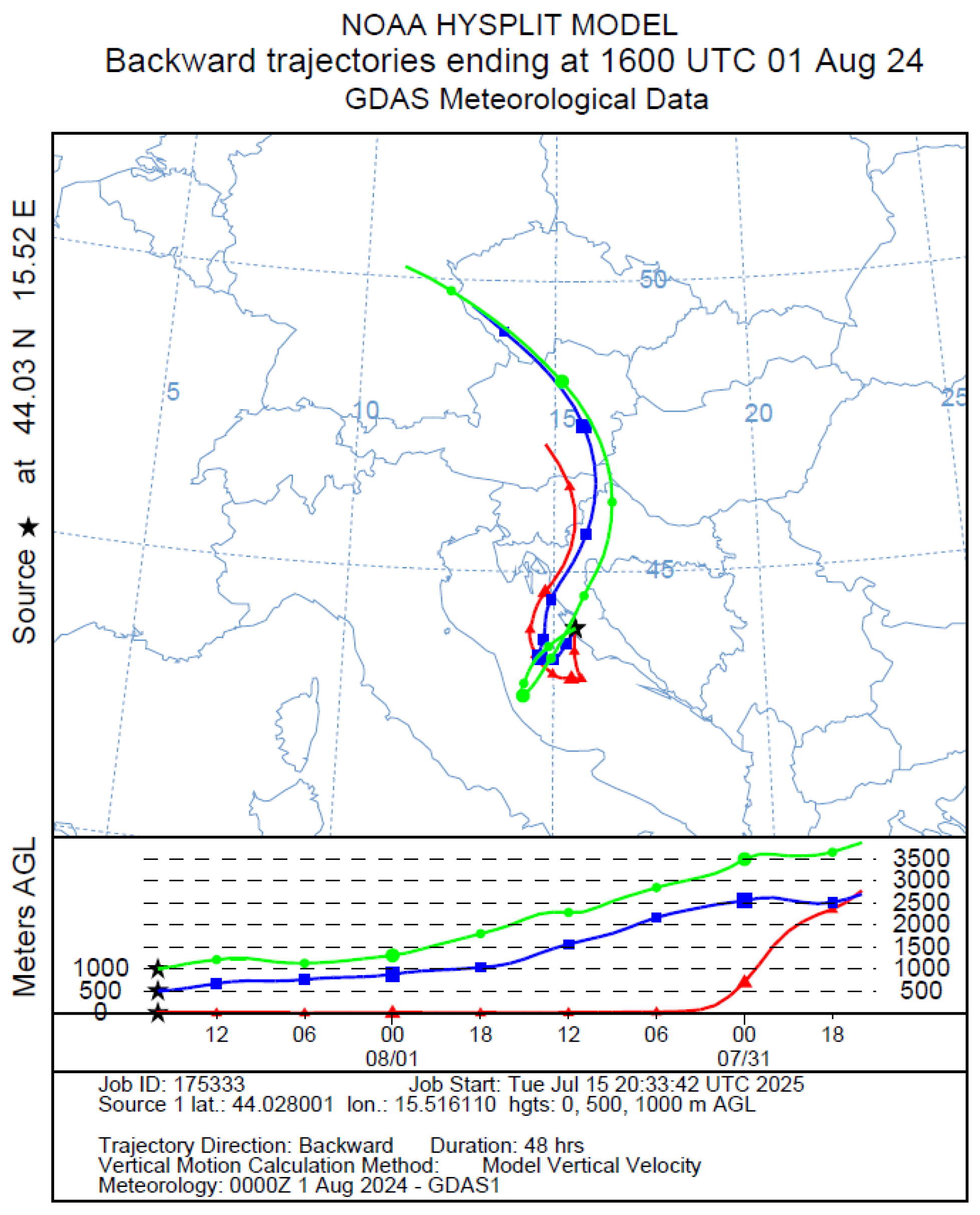


| PM10 | PM2.5 | |||||||||
|---|---|---|---|---|---|---|---|---|---|---|
| 30 July 2024 | 31 July 2024 | 1 August 2024 | 2 August 2024 | Annual Value (Average ± SD) | 30 July 2024 | 31 July 2024 | 1 August 2024 | 2 August 2024 | Annual Value (Average ± SD) | |
| OC/EC | 17.5 | 10.2 | 12.0 | 12.9 | 8.1 ± 4.3 | 17.8 | 10.2 | 13.3 | 12.2 | 9.4 ± 4.6 |
| POC/OC | 0.089 | 0.154 | 0.130 | 0.122 | 0.245 ± 0.131 | 0.186 | 0.326 | 0.249 | 0.271 | 0.428 ± 0.174 |
| OC1/OC | 0.143 | 0.086 | 0.103 | 0.104 | 0.121 ± 0.068 | 0.099 | 0.075 | 0.107 | 0.103 | 0.103 ± 0.042 |
| OC2/OC | 0.325 | 0.349 | 0.277 | 0.317 | 0.176 ± 0.093 | 0.331 | 0.355 | 0.285 | 0.322 | 0.246 ± 0.091 |
| OC3/OC | 0.191 | 0.190 | 0.183 | 0.188 | 0.164 ± 0.065 | 0.214 | 0.224 | 0.202 | 0.218 | 0.184 ± 0.058 |
| OC4/OC | 0.124 | 0.120 | 0.171 | 0.163 | 0.275 ± 0.165 | 0.119 | 0.078 | 0.096 | 0.100 | 0.185 ± 0.134 |
| PyrC/OC | 0.216 | 0.256 | 0.265 | 0.228 | 0.268 ± 0.079 | 0.237 | 0.267 | 0.309 | 0.256 | 0.281 ± 0.103 |
| LG/MNS | 1.1 | 5.3 | 1.7 | 5.4 | / | 2.1 | 7.0 | 2.8 | 2.1 | / |
| LG/WSOC | 0.003 | 0.147 | 0.001 | 0.004 | 0.032 ± 0.039 | 0.004 | 0.129 | 0.008 | 0.003 | 0.052 ± 0.082 |
| LG/OC1 | 0.018 | 0.806 | 0.008 | 0.029 | 0.211 ± 0.274 | 0.022 | 0.767 | 0.047 | 0.015 | 0.264 ± 0.300 |
| LG/OC2 | 0.008 | 0.198 | 0.003 | 0.010 | 0.157 ± 0.281 | 0.006 | 0.161 | 0.018 | 0.005 | 0.118 ± 0.155 |
| LG/OC3 | 0.014 | 0.365 | 0.005 | 0.016 | 0.151 ± 0.210 | 0.010 | 0.255 | 0.025 | 0.007 | 0.129 ± 0.137 |
| LG/OC4 | 0.021 | 0.576 | 0.005 | 0.019 | 0.126 ± 0.220 | 0.018 | 0.732 | 0.053 | 0.016 | 0.167 ± 0.203 |
| LG/PyrC | 0.012 | 0.270 | 0.003 | 0.013 | 0.072 ± 0.082 | 0.009 | 0.214 | 0.016 | 0.006 | 0.099 ± 0.270 |
| BC/EC | / | / | / | / | / | 0.886 | 0.778 | 1.830 | 1.044 | 1.079 ± 0.394 |
| LG/BC_bb | / | / | / | / | / | 0.184 | 1.457 | 0.104 | 0.079 | 0.527 ± 0.671 |
Disclaimer/Publisher’s Note: The statements, opinions and data contained in all publications are solely those of the individual author(s) and contributor(s) and not of MDPI and/or the editor(s). MDPI and/or the editor(s) disclaim responsibility for any injury to people or property resulting from any ideas, methods, instructions or products referred to in the content. |
© 2025 by the authors. Licensee MDPI, Basel, Switzerland. This article is an open access article distributed under the terms and conditions of the Creative Commons Attribution (CC BY) license (https://creativecommons.org/licenses/by/4.0/).
Share and Cite
Sopčić, S.; Godec, R.; Prskalo, H.; Pehnec, G. Impact of a Summer Wildfire Episode on Air Quality in a Rural Area Near the Adriatic Coast. Fire 2025, 8, 299. https://doi.org/10.3390/fire8080299
Sopčić S, Godec R, Prskalo H, Pehnec G. Impact of a Summer Wildfire Episode on Air Quality in a Rural Area Near the Adriatic Coast. Fire. 2025; 8(8):299. https://doi.org/10.3390/fire8080299
Chicago/Turabian StyleSopčić, Suzana, Ranka Godec, Helena Prskalo, and Gordana Pehnec. 2025. "Impact of a Summer Wildfire Episode on Air Quality in a Rural Area Near the Adriatic Coast" Fire 8, no. 8: 299. https://doi.org/10.3390/fire8080299
APA StyleSopčić, S., Godec, R., Prskalo, H., & Pehnec, G. (2025). Impact of a Summer Wildfire Episode on Air Quality in a Rural Area Near the Adriatic Coast. Fire, 8(8), 299. https://doi.org/10.3390/fire8080299





